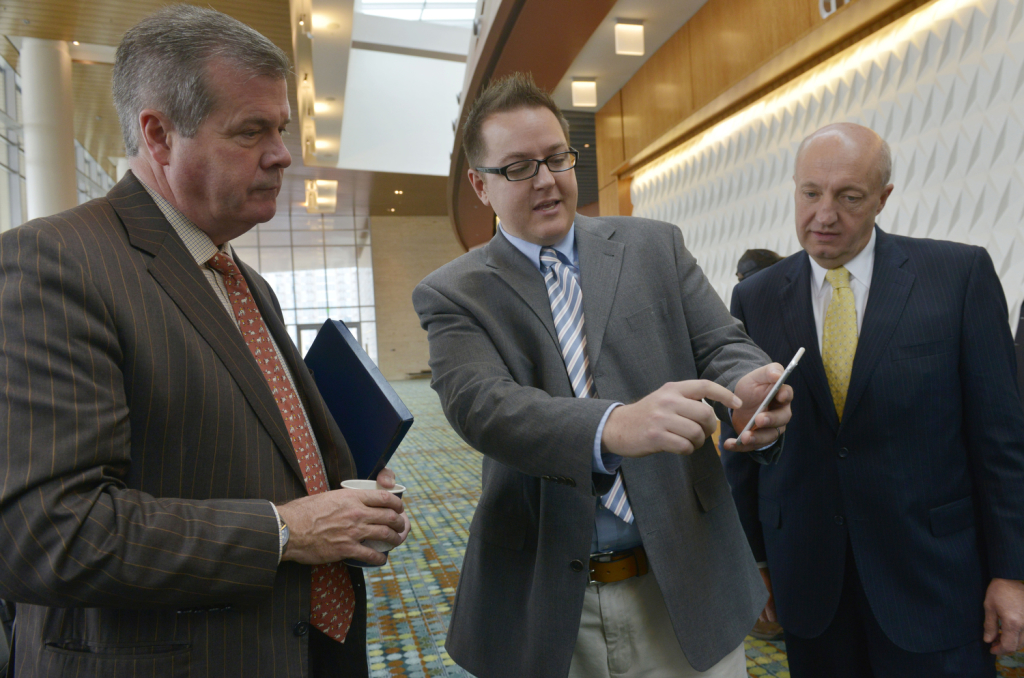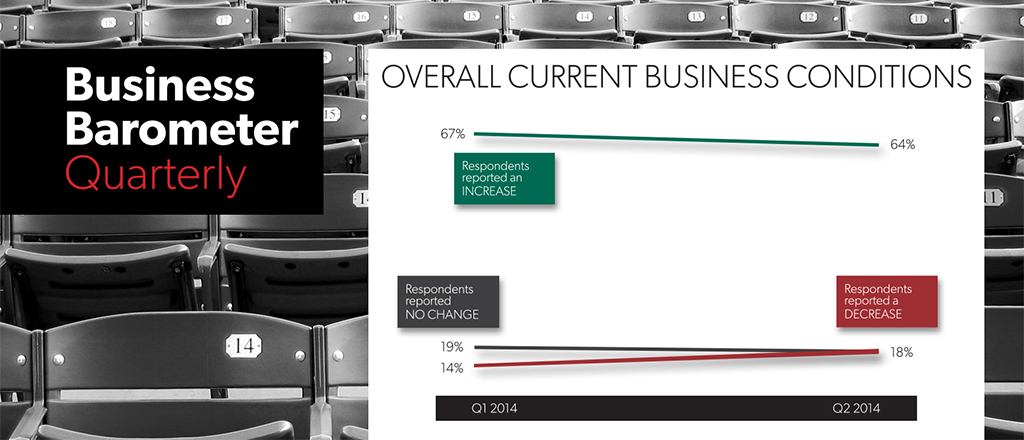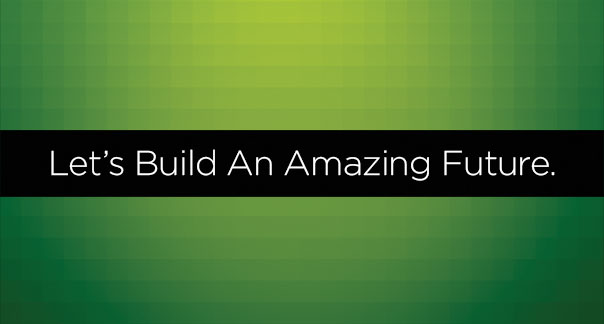Blue, Red, and….Greening the Holidays
The holidays are full of cheer, joy, family, and trash. Yes, tons of trash. According to the Environmental Protection Agency, Americans throw away 25 percent more trash during the Thanksgiving to New Year’s holiday period than any other time of year. The extra waste amounts to 25 million tons of garbage, or about one million extra tons per week. This trash includes wrapping paper, food waste, packaging, decorations, and old “toys” that are dumped for new ones every year.
The holiday season is a great way for venues to take action and save the holidays by making them greener. Instead of using a real tree, use a fake one that can be stored and reused each year. Also, find decorations that can have multiple purposes and reused in different fashions for a new look from year to year. Facility managers can even encourage employees to bring in unused items from home that they can use to help decorate the facility.
When using holiday lights, remember to use LED and energy efficient lights. LED lights consume 80 percent to 90 percent less energy and last up to 100,000 hours versus 3,000 hours for incandescent. Also, if you set them on a timer, you can save energy when the facility is vacant. And remember to be gentle when the season is finally over so you can pack them away to be used over and over again.
Another way to be more green this holiday season is to send electronic cards to vendors, sponsors, co-workers, and all your important business contacts, instead of mailing cards that get tossed in the trash.
Finally, encourage holiday party clients to be more environmentally friendly by donating leftover food from parties, recycling wrapping paper, and reusing decorations.
For more tips on going green this holiday, visit: http://www.epa.gov/epahome/hi-winter.htm or http://money.cnn.com/2010/12/16/news/economy/holiday_trash/. So instead of a “Blue Christmas,” how about making it a Green one?!
Music City Center Unveils Its New Wayfinding App

Mayor Karl Dean; Jules White, an assistant professor at Vanderbilt and developer of the Music City Center wayfinding app; and IAVM member Charles Starks, president and CEO of the Music City Center, use the Music City Center wayfinding app.
Getting lost is a thing of the past for visitors in Nashville’s Music City Center (MCC) thanks to its new wayfinding app.
“This new technology will change the way visitors experience this building,” Nashville Mayor Karl Dean said. “It’s a big building, and getting turn-by-turn directions on a phone will make it easier for visitors to get where they need to go. This wayfinding app also highlights Nashville’s emergence as a tech city and a place where entrepreneurs and Web developers feel empowered to come up with tools to make life easier and better.”
The app uses beacons installed in the building’s walls to direct users from point A to point B in the venue. At 1.2 million square feet, the MCC is the largest building in the country with an indoor wayfinding system that uses beacon technology. It is available as a free app for iPhone and Android users.
The app was created by Jules White, an assistant professor of electrical engineering and computer science at Vanderbilt University—along with a team of Vanderbilt students as a part of a class project. The public/private partnership between the MCC and Vanderbilt’s Institute for Software Integrated Systems led to the development of the wayfinding technology and the launch of White’s new Nashville-based startup company, Ziiio.
The MCC wayfinding system functions like indoor GPS and is the first of its kind to clearly show users turn-by-turn how to find where they want to go inside a building using 500 photos. The machine-learning approach that Ziiio uses allows the MCC to rely on fewer beacons. Currently, 62 beacons have been deployed in the convention center. These beacons were donated by BKON, a local manufacturer of the iBeacon hardware.
A video demonstration is at: https://drive.google.com/file/d/0B_HZ5vVmyi8kZ1ZIRjkxQl9WeEE/view?usp=sharing.
Kim Stone Inducted into N.C. Hall of Fame for Journalism
 Congratulations to IAVM member Kim Stone, executive vice president and general manager of the AmericanAirlines Arena in Miami, Florida. She was recently inducted into the University of North Carolina’s Hall of Fame in Journalism.
Congratulations to IAVM member Kim Stone, executive vice president and general manager of the AmericanAirlines Arena in Miami, Florida. She was recently inducted into the University of North Carolina’s Hall of Fame in Journalism.
Stone has been with the Miami Heat organization since the mid-1990s and has worked in several capacities, from media relations to director of operations to her current role as general manager.
Prior to joining the Heat, Stone was the sports publicity director for the University of Texas Women’s Athletics Department from 1992-94. Before that, she was an assistant in the University of Miami’s sports information office.
Stone received the 2013 Women of Influence award from Venues Today magazine, and she was honored in 2009 by the South Florida Business Journal in its inaugural class of Influential Business Women.
Stone graduated with a degree in journalism and public relations from the University of North Carolina, where she assisted in the sports information office. In 2003, she graduated with honors from the University of Miami with a master’s degree in international business administration. She is formerly an adjunct professor in the St. Thomas University Masters of Sports Administration program and serves as a board member of the University of Miami’s President’s Council, Miami Downtown Development Authority, and is currently president of the Florida Facility Manager’s Association.
Congratulations, Kim!
(Image: NBA.com)
IAVM’s First Business Barometer Quarterly Now Available
Welcome to the first quarterly of IAVM’s Business Barometer, a new product from VenueDataSource.
Launched in April 2013, Business Barometer is a tool to help IAVM members monitor current and future business conditions and provide early identification of trends that can create opportunities or provide advance warning of an impending storm. IAVM recruited a panel of 250 venue managers to take part in this initiative. All panel members agreed to participate in short, quarterly surveys that ask questions related to current business conditions compared to last year, and their professional outlook for next year. IAVM developed the survey questions with input from its Research Advisory Council, the IAVM research manager, and other internal management staff.
In this first quarterly, venues across the industry are seeing increases in attendance and revenue over the year prior—and the outlook for the coming year is even better. More than two-thirds of professionals across sectors (64 percent) say that overall business conditions are better than 2013. Next year? Eighty percent see a healthier future.
Anecdotally, for those citing the greatest influx of business, touring acts and the types of events may have improved since last year, which means better ticket and merchandise sales—and higher prices—for some and more exhibit hall space booked for others.
Consider this when looking at the marketplace environment overall: 18 percent of venues report worse business conditions than last year—but only 5 percent see that continuing into the next.
Please read the Business Barometer to learn more about venue industry business conditions.
How the IAVM Foundation Has Affected My Career
Two years have passed since I had the opportunity to participate as a student volunteer at the Venue Management School in Oglebay and VenueConnect 2012 through the IAVM Foundation. As I reflect on these two experiences, I’m flooded with only positive memories. I find it incredible that the Foundation could bring along people from different parts of the country with different interests, personalities, and lifestyles representing various universities while expecting them to work together for a week. Even with all of these contrasts, great things always come to pass.
I believe “Without a vision, the people perish.” The opportunities through the IAVM Foundation will help any aspiring venue manager fulfill his or her vision. Through networking and seminars within various conferences, friendships are built, knowledge is gained, and a sense of community is felt among those in our industry.
Those friendships built not only stay within that week but progress as we develop in our careers. The encouragement and camaraderie from these friendships are still felt to this day and becomes infectious. The knowledge gained becomes a useful tool in broadening our growth within the industry and gives us the opportunity to make a positive impact within our venues. There’s a sense of community in our industry where you can put strangers together with the same goals and see success. It’s that same sense of community, where members are willing to assist other members selflessly. If it be for another member’s expertise on a certain subject or to brainstorm an outcome of a situation, our members are there. Try it out yourself, and see the floodgates of benefits and success open.
Hence, I feel a connection to all IAVM Foundation student volunteers. Now as a Young Professional, I admire those students who have a vision of where they want to go in their careers. The ambition of others is what fuels me even more to take steps to fulfill my own vision. Taking action and initiative, such as participating in the IAVM Foundation, is enlightening. As a student volunteer, I loved hearing where other students wanted to go in their lives, and based off of working with them, I could see each person attaining his or her vision.
I believe any person who has any interest in the venue management industry must take advantage of the opportunities the Foundation has to offer. There is no other opportunity within our industry where you could meet some of the most talented and respected venue managers from throughout the world. This includes the most talented and respected allied members. Their experiences and knowledge is beneficial to anyone’s growth within the industry and in your own personal life. As I look forward to the many new opportunities the Foundation is going to present in the upcoming months, I do look forward to meeting with the student volunteers. I know what it was like to be in their situation. Most importantly, I know what the Foundation has done for me, and I would like to help them take those steps so they could fulfill their visions, as well.
I would like to invite all students to start researching and applying to the various internships the IAVM Foundation provides. I have much gratitude to our members who encouraged me to these internships. You are the next generation, and the IAVM Foundation will prepare you for continual success in your careers.
Do you want to receive a Front Row News weekly digest?
Categories
- Allied (861)
- Architecture (147)
- Arenas (747)
- Career (897)
- Convention Centers (895)
- Education (623)
- Events (1,544)
- Food & Beverage (193)
- Foundation (113)
- Guest Experience (1,496)
- Industry News (2,270)
- Leadership (1,888)
- Marketing (150)
- Membership (2,000)
- Music (213)
- Performing Arts Centers (454)
- Professional Development (409)
- Research (127)
- Safety & Security (442)
- Sports (763)
- Stadiums (608)
- Student (159)
- Technology (516)
- Ticketing (92)
- Touring (82)
- Trends (364)
- Uncategorized (745)
- Universities (218)
- Video (25)
- Young Professional (198)
Twitter Feed
- Twitter feed loading
Recent Posts
- VenuWorks Selected To Manage Historic Paramount Arts Center In Ashland
- Miami Beach Convention Center Wraps a Milestone Year
- Venuworks and ATG Entertainment Selected to Manage Fresno Convention and Entertainment Center
- Seattle Convention Center Announces Strategic Leadership Appointment and Growth Initiatives for 2026
- Peggy Daidakis Humbly Made Convention Center History
Categories
- Allied
- Architecture
- Arenas
- Career
- Convention Centers
- Education
- Events
- Food & Beverage
- Foundation
- Guest Experience
- Industry News
- Leadership
- Marketing
- Membership
- Music
- Performing Arts Centers
- Professional Development
- Research
- Safety & Security
- Sports
- Stadiums
- Student
- Technology
- Ticketing
- Touring
- Trends
- Uncategorized
- Universities
- Video
- Young Professional
Archives
- January 2026
- December 2025
- November 2025
- October 2025
- September 2025
- August 2025
- July 2025
- June 2025
- May 2025
- April 2025
- March 2025
- February 2025
- January 2025
- December 2024
- November 2024
- October 2024
- September 2024
- August 2024
- July 2024
- June 2024
- May 2024
- April 2024
- March 2024
- February 2024
- January 2024
- December 2023
- November 2023
- October 2023
- September 2023
- August 2023
- July 2023
- June 2023
- May 2023
- April 2023
- March 2023
- February 2023
- January 2023
- December 2022
- November 2022
- October 2022
- September 2022
- August 2022
- July 2022
- June 2022
- May 2022
- April 2022
- March 2022
- February 2022
- January 2022
- December 2021
- November 2021
- October 2021
- September 2021
- August 2021
- July 2021
- June 2021
- May 2021
- April 2021
- March 2021
- February 2021
- January 2021
- December 2020
- November 2020
- October 2020
- September 2020
- August 2020
- July 2020
- June 2020
- May 2020
- April 2020
- March 2020
- February 2020
- January 2020
- December 2019
- November 2019
- October 2019
- September 2019
- August 2019
- July 2019
- June 2019
- May 2019
- April 2019
- March 2019
- February 2019
- January 2019
- December 2018
- November 2018
- October 2018
- September 2018
- August 2018
- July 2018
- June 2018
- May 2018
- April 2018
- March 2018
- February 2018
- January 2018
- December 2017
- November 2017
- October 2017
- September 2017
- August 2017
- July 2017
- June 2017
- May 2017
- April 2017
- March 2017
- February 2017
- January 2017
- December 2016
- November 2016
- October 2016
- September 2016
- August 2016
- July 2016
- June 2016
- May 2016
- April 2016
- March 2016
- February 2016
- January 2016
- December 2015
- November 2015
- October 2015
- September 2015
- August 2015
- July 2015
- June 2015
- May 2015
- April 2015
- March 2015
- February 2015
- January 2015
- December 2014
- November 2014
- October 2014
- September 2014
- August 2014
- July 2014
- June 2014
- May 2014
- April 2014
- March 2014
- February 2014
- January 2014
- December 2013
- November 2013
- October 2013
- September 2013
- August 2013
- July 2013
- June 2013
- May 2013
- April 2013
- March 2013
- February 2013
- January 2013
- May 2012
- March 2012
- December 2011
- November 2011
- October 2011
Recent Comments
- Frank Bradshaw, Ph.D., CVE on John Meyer, CVE, a Tireless Advocate of Certification for Venue Professionals, Has Died
- Neil Sulkes on Hilary Hartung, Friend to Many in Venue Marketing, Has Left Us
- Jason Parker, CVE on The Devastation of Hurricane Helene and How We Can Support One Another
- Larry Perkins on Touhey Testifies Against Speculative Ticketing Before Congressional Subcommittee
- Peter Secord on Major Players for Planned Elkhart Amphitheater Were in the Mix at VenueConnect



